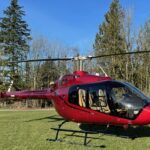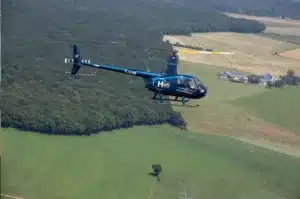
What sectors are in demand for pilots?
The employment opportunities for pilots heavily depend on the geographical area in which they operate, as well as their field of activity (refer to our previous article on employment opportunities immediately after completing your double CPLH at CEFA). It is difficult to pinpoint which sectors are in demand for pilots, as they can work in various situations (such as documentary filming, cinematic productions, heavy cargo lifting, etc.).
In this article, you will discover the different sectors facing a shortage of pilots, offering numerous positions with attractive salaries. What are they? How many pilot profiles are typically sought after each year on average? CEFA, the helicopter flight school in Luxembourg and Marne (France), reveals all.
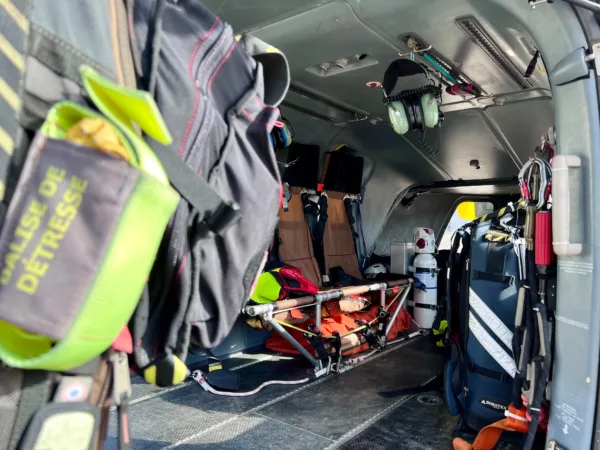
Emergency medical services
Helicopters play a crucial role within emergency medical services. They provide rapid and efficient responses to critical medical situations, interventions in high-risk areas where transportation can be perilous, difficult to access, and requires swift intervention. The demand for pilots is high, especially in high-risk areas, mountainous regions, or maritime areas. At the heart of this crucial mission, the increasing demand for qualified pilots is a real concern, significantly influencing opportunities in this specialized sector.
Here are the various missions carried out in this pilot-shortage sector:
The use of helicopters in emergency medical services is intrinsically linked to the imperative of rapidly transporting patients to hospital facilities. In medical emergencies, every minute plays a crucial role, and swift access to medical care can be the decisive factor between life and death. Helicopters, with their ability to overcome geographical and road obstacles, serve as essential vectors, providing unmatched speed, particularly crucial in hard-to-reach areas or during traffic congestion.
Helicopter pilots in emergency medical services are frequently called upon to operate in hard-to-reach areas. Whether it’s isolated rural areas, mountainous terrain, or disaster-stricken locations, helicopters offer unmatched flexibility to reach patients where ground ambulances may be limited. This ability to intervene in complex situations positions helicopter pilots as indispensable actors, ensuring swift care in places where it would otherwise be impracticable.
In medical emergency situations, the stability and precision of the aircraft are of crucial importance. Helicopter pilots specialized in emergency medical services are specifically trained to operate in demanding conditions, ensuring safe and stable transportation of medical teams and patients. Their expertise is tested during delicate takeoffs and landings, especially in unprepared sites, where each maneuver requires exceptional technical mastery.
Conclusion
The demand for helicopter pilots in the emergency medical services sector is steadily growing due to the expansion of air emergency services globally. The imperative of a rapid response to critical medical situations highlights the crucial importance of having a sufficient number of qualified pilots to ensure uninterrupted coverage, 24 hours a day, 7 days a week. This trend underscores the urgency of implementing tailored recruitment and training strategies to meet this increasing demand and ensure the continuity of this vital service.
Oil and Gas Drilling Operations
The oil and gas industry, known for its complex offshore operations, heavily relies on helicopters for essential personnel transportation to offshore platforms. This significant dependence results in a growing demand for helicopter pilots, an indispensable necessity within the operational dynamics of this strategic sector.
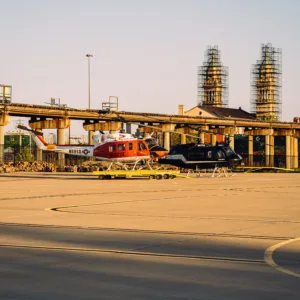
Here are the various missions carried out by helicopter pilots in this sector:
In the context of offshore oil and gas operations, platforms located at sea require fast and reliable means of transportation to ferry personnel from the mainland to offshore installations. Helicopters emerge as the preferred choice due to their ability to overcome vast stretches of water, providing a swift and efficient solution to meet the specific logistical requirements of this sector.
Operations on offshore platforms often involve a critical need for personnel rotation. Teams work in shifts, spending a certain number of days on the platform before being relieved by freshly arrived colleagues. Helicopters ensure flawless logistics, enabling swift rotations and minimizing downtime, an essential aspect in a sector where operational continuity is crucial.
Offshore platforms are often located in remote and sometimes hard-to-reach areas. Helicopters provide access to these isolated sites, overcoming challenges posed by maritime distances and variable weather conditions. Helicopter pilots play a central role in these missions, requiring expertise to navigate safely in sometimes hostile environments.
In addition to personnel transport, helicopters are also used for surveillance and maintenance missions of offshore installations. Pilots are involved in operations such as visual inspection of equipment, transportation of materials, and emergency evacuation when needed. Their role extends beyond mere transportation, encompassing varied tasks essential for the proper functioning of offshore installations.
Conclusion
This intensive use of helicopters in the oil and gas industry results in a growing demand for qualified pilots. The sensitive and strategic nature of these offshore operations underscores the crucial importance of having a workforce of trained and experienced pilots to ensure safety, efficiency, and continuity of activities in this vital sector. The need for regular personnel rotation and 24/7 operations further strengthens this demand, making helicopter pilots indispensable actors in the offshore oil and gas ecosystem.
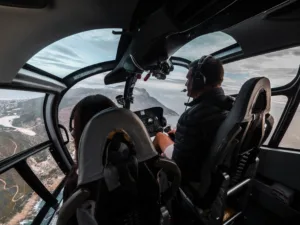
Aerial Work and Lifting:
At the core of the aerial work and lifting industry, helicopters emerge as versatile tools used for missions as varied as heavy lifting and antenna installation. This functional diversity creates a pressing demand for helicopter pilots, essential professionals to ensure precision and safety in often complex and demanding situations.
Here are the missions of the helicopter pilot in this sector:
One of the key roles of helicopters in this sector is heavy lift operations. Whether it’s for construction projects, mountain interventions, or engineering projects requiring the movement of significant loads, helicopters offer unparalleled mobility. Helicopter pilots are responsible for maneuvering with precision, lifting and moving sometimes massive loads, a task that demands technical expertise and complete mastery of the aircraft.
Helicopters are also employed for infrastructure works, including the installation of antennas and high-rise structures. Pilots play a crucial role in these delicate operations, navigating with precision to position loads while closely collaborating with ground teams. This use of helicopters in urban or hard-to-reach contexts underscores the need for pilot expertise specific to this sector.
Aerial work and lifting operations may involve interventions in hard-to-reach areas. Whether in mountains, dense forests, or urban environments, helicopters provide the flexibility needed to reach delicate locations. Pilots face challenges such as restricted spaces, changing weather conditions, and specific operational requirements, making their expertise an invaluable asset.
Beyond lifting missions, helicopters are also used for the surveillance and maintenance of infrastructure. Pilots are involved in tasks such as visual inspection of structures, maintenance of power lines, or repair of high-rise installations. Their role extends beyond mere cargo transport, encompassing varied activities that contribute to the safety and sustainability of infrastructure.
Conclusion
The diversity of missions in aerial work and lifting leads to a strong demand for pilots and numerous job opportunities. The need for specialized skills to operate in various contexts, combined with the specificity of lifting and installation missions, makes pilots key players in the success of projects in this sector. The required precision, variety of missions, and increasing demand for services in this field underscore the crucial importance of having a qualified and dedicated workforce to meet the evolving needs of this thriving industry.
Pilot in Training Centers, Instructor, and Trainer:
Within the aviation industry, the training of new helicopter pilots holds a crucial position, shaping the next generation of professionals capable of maneuvering these complex aircraft. However, this specific sector is currently facing challenges, with demand often outstripping supply, particularly within flight schools and training centers.

Here are the various missions of the training pilot:
Helicopter pilots play a fundamental role in transmitting knowledge and expertise to future pilots. They participate in flight and ground training sessions, sharing their in-depth knowledge of navigation, aviation safety, emergency procedures, and many other crucial aspects of helicopter flying. Their practical experience and technical skills contribute to training competent pilots prepared to face the various challenges of helicopter flight.
Helicopter pilots, as instructors, also oversee flight simulation sessions and practical exercises in the field. These simulations are essential to familiarize new pilots with real scenarios and develop their reflexes in emergency situations. The instructor plays a crucial role in creating a safe yet challenging learning environment where future pilots can gain the confidence needed to operate these complex machines.
In the training process, helicopter pilots assess the individual progress of apprentices, identifying the strengths and weaknesses of each student. Individual mentoring is particularly important in pilot training as it allows for tailoring instruction to the specific needs of each student. Instructors guide apprentices through the challenges of helicopter flying, preparing them to operate autonomously and responsibly in various situations.
Conclusion: Demand Exceeds Supply
The demand for qualified helicopter pilots to provide training often exceeds the available supply, especially within flight schools and training centers. This situation arises from several factors, including the continuous growth of the aviation industry, the need to adapt training to constantly evolving regulatory standards, and the gradual retirement of experienced pilots. The constant quest for new competent pilots to meet these needs poses a crucial challenge, highlighting the necessity to invest in training and recruitment programs to support the continuous development of this essential profession.
There are increasingly more opportunities
The demand for helicopter pilots is experiencing significant growth in various sectors such as emergency medical services, oil and gas drilling, aerial work and lifting, as well as pilot training. These needs arise from specific missions such as rapid patient transport, complex offshore operations, lifting work, and knowledge transmission in flight schools. Faced with this increasing demand, the necessity for tailored recruitment and training initiatives becomes imperative to ensure a qualified workforce and address the challenges of the aviation industry.
CEFA is the European Center for Aeronautical Training specialized in helicopter pilot training. For any inquiries about our training programs, contact us! Our partners provide job opportunities upon completion of the training in various sectors to all our aspiring pilots.
Interested in exploring the world of helicopter pilots? Contact us!
CEFA – Centre Européen de Formation Aéronautique
- Aérodrome de Reims-Prunay, 51360 Prunay
- [email protected]
- 07 49 94 35 32
Our branch in Luxembourg
- 13-15, Rue de l'industrie L-8069 Bertrange Luxembourg
- [email protected]
- +352 2630761
Our training offerings:
Becoming a pilot in Europe and Canada
Becoming a pilot in Europe specifically
To become a pilot for personal enjoyment
To convert your license and fly in Europe

